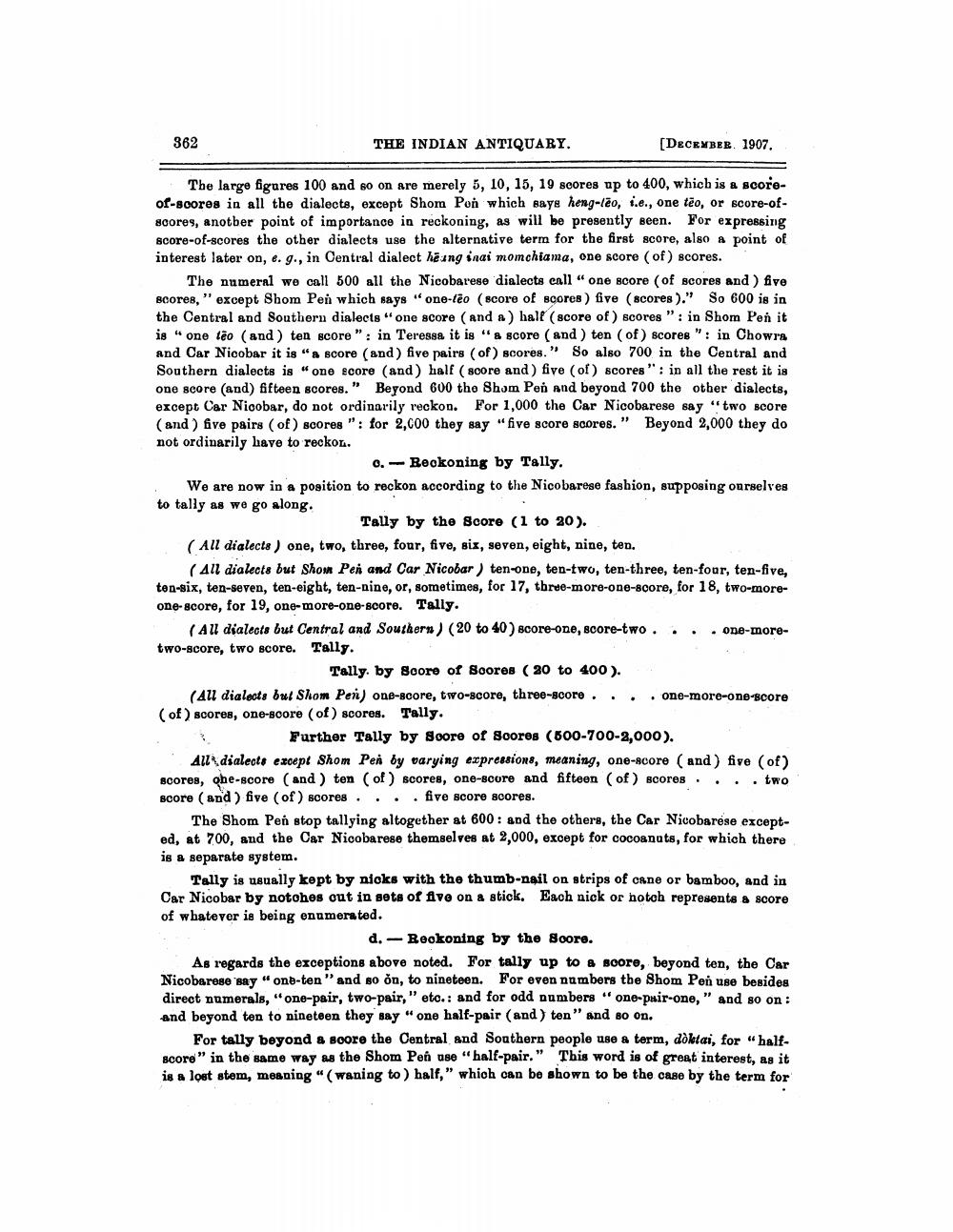________________
362
THE INDIAN ANTIQUARY.
[DECEMBER 1907.
+ The large figures 100 and so on are merely 5, 10, 15, 19 scores up to 400, which is a scoreof-scores in all the dialects, except Shom Pon which saye heng-leo, i.e., one teo, or score-ofscores, anotber point of importance in reckoning, as will be presently seen. For expressing score-of-scores the other dialects use the alternative term for the first score, also a point of interest later on, e.g., in Central dialect heung inai momchiama, one score (of) scores.
The numeral we call 500 all the Nicobarese dialects call“ one score (of scores and ) five scores," except Shom Pen which says "one-leo (score of scores) five (scores)." So 600 is in the Central and Southern dialects one score (and a hall (score of) scores": in Shom Pen it is “one teo (and) ten score": in Teressa it is "& score (and) ten (of) scores" : in Chowra and Car Nicobar it is "& score (and) five pairs (of) scores." So also 700 in the Central and Southern dialects is one ecore (and) half (score and ) five (of) scores": in all the rest it is one score (and) fifteen scores." Beyond 600 the Shum Peň and beyond 700 the other dialects, except Car Nicobar, do not ordinarily reckon. For 1,000 the Car Nicobarese say "two score (and ) five pairs (of) scores ": for 2,000 they say "five score scores." Beyond 2,000 they do not ordinarily have to reckon.
0. - Beckoning by Tally. . We are now in a position to reckon according to the Nicobarese fashion, supposing ourselves to tally as we go along.
Tally by the Score (1 to 20). (All dialects) one, two, three, four, five, six, seven, eight, nine, ten.
(41l dialects but shom Pen and Car Nicobar ) ten-one, ten-two, ten-three, ten-four, ten-five, ten-six, ten-seven, ten-eight, ten-nine, or, sometimes, for 17, three-more-one-score, for 18, two-moreone-score, for 19, one-more-one-score. Tally.
(All dialects but Central and Southern) (20 to 40 ) score-one, score-two .... one-moretwo-score, two score. Tally.
Tally, by score of Soores ( 20 to 400 ). (Al dialects but Shom Pen) ONB-score, two-score, three-score.... one-more-one-score (of) scores, one-score (of) scores. Tally.
Further Tally by Soore of Soores (600-700-2,000). All dialects except Shom Pen by varying expressions, meaning, one-ncore (and) five (of) scores, ghe-score (and ) ten (of) scores, one-score and fifteen (of) scores ... two score (and ) five (of) scores. ... five score scores.
The Shom Pen stop tallying altogether at 600 : and the others, the Car Nicobarese excepted, at 700, and the Car Nicobarese themselves at 2,000, except for cocoanats, for which there is a separate system.
Tally is usually kept by nioks with the thumb-ngil on strips of cane or bamboo, and in Car Nicobar by notohes out in sets of five on a stick. Each nick or hotch represents a score of whatever is being enumerated.
d. - Reckoning by the Soore. As regards the exceptions above noted. For tally up to a score, beyond ten, the Car Nicobarese 'say "onb-ten" and so on, to nineteen. For even numbers the Shom Pen use besides direct numerals, "one-pair, two-pair," etc.: and for odd numbers "one-pair-one," and so on : and beyond ten to nineteen they say "one half-pair (and) ten" and so on.
For tally beyond & soore the Central and Southern people use & term, dòktai, for halfBcore" in the same way as the Shom Pen use "half-pair." This word is of great interest, as it is a lost stem, meaning " (waning to half," which can be shown to be the case by the term for




